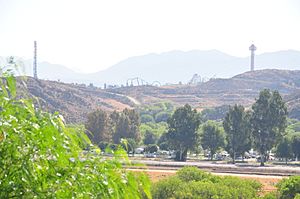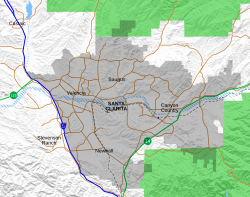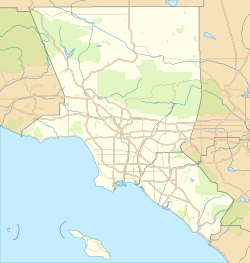Valencia, California facts for kids
Quick facts for kids
Valencia, California
|
|
|---|---|

Valencia with Magic Mountain theme park in background
|
|
| Country | United States |
| State | California |
| County | Los Angeles |
| Named for | The Valencia orange |
| ZIP Codes |
91355, 91381
|
| Area code(s) | 661 |
Valencia is a growing area in Los Angeles County, California, in the United States. It's not officially a city but a "community" that's part of the county. You'll find it west of Interstate 5, stretching across State Route 126 and the Santa Clara River.
This area is seeing a lot of new homes, shops, and businesses being built. A huge new development called Great Park is under construction. It was first planned a long time ago by a company called Newhall Land. After some delays and environmental concerns, building finally started in 2017. This new area is right next to Six Flags Magic Mountain, a popular amusement park.
Contents
History of Valencia
This land has a long history. Native American groups, like the Tataviam people and Chumash people, lived here many centuries ago.
How Valencia Began
For a long time, the land was used for farming and ranching. In the 1960s, the Newhall Land and Farming Company decided to build a new community here. They named it Valencia after the Valencia orange fruit, which used to grow in the area.
In 1967, a major highway, Interstate 5, was completed through the Santa Clarita Valley. This made it easier to travel south to the San Fernando Valley. That same year, the first homes in Valencia were finished. The idea was to create a complete community with stores, parks, hospitals, and schools.
A big part of Valencia's early development was the Magic Mountain amusement park. Construction began in 1969, and the park opened its doors on May 29, 1971. It was first developed by the Newhall Land and Farming Company and Sea World Inc.
Growth and Development
By the late 1980s, Newhall Land owned a huge amount of undeveloped land near Los Angeles. They had already built many homes, apartments, and condos in the Valencia area. They also had plans for more homes and business parks. Many companies bought land from Newhall Land to build their own offices and factories.
In 1987, the nearby city of Santa Clarita was formed. It included parts of Valencia that were already built. However, the city leaders were worried about how much traffic and environmental problems the new developments, like the Great Park (then called Newhall Ranch), might cause. They also wanted these new areas to be part of their city.
Expanding West of Interstate 5
In 1990, the county decided that the area west of Interstate 5, known as Newhall Ranch, could be developed. In 1995, Newhall Land started building the Valencia Marketplace. This became a big shopping area and brought a lot of sales tax money to Valencia.
By 1996, Newhall Land had developed a large part of Valencia, including many homes. The area also became a hub for businesses, with many industrial and office spaces being built. Big companies like Remo, Pharmavite, and Mechanix Wear have locations here.
New communities like Westridge were also built. The TPC Valencia golf course in Westridge was later renamed The Oaks Club at Valencia in 2018.
The city of Santa Clarita tried to include these western areas into its city limits several times. However, Newhall Land preferred that the area west of Interstate 5 remain part of the county, saying there were no city services there. In 2009, residents in these unincorporated communities voted on whether to join Santa Clarita or stay part of the county. Most chose to stay unincorporated.
Building the Great Park Development
The Great Park development, previously known as Newhall Ranch, faced many challenges before construction could begin. Environmental groups and others filed lawsuits, worried about the impact on nature. These legal battles caused many delays and changes to the plans.
The project is located near the Santa Clara River, which is an important natural area in Southern California. The construction plans involved changing parts of the river's flood plain and tributaries. This area is home to many native plants and animals, including some that are rare or endangered.
The plans for the Great Park include:
- Building 21,500 homes.
- A commercial district with shops and businesses.
- Seven public schools.
- Three fire stations.
- Parks, a golf course, and a lake.
- Setting aside 10,000 acres of permanent open space.
- Developing 50 miles of trails for walking and biking.
A water treatment plant will also be built to clean water from the development before it flows into the Santa Clara River.
After many years of legal discussions and changes to the plans, the California Department of Fish and Wildlife approved the environmental report in 2017. The Los Angeles County Board of Supervisors also approved the building permits.
New Construction Begins
Building for the Great Park development officially started in 2017. The first area, called Mission Village, is now under construction. It will have 4,000 homes and a "downtown style" center with shops and businesses. Other areas like Homestead Village and Portero Village are also being planned. As of mid-2022, many new homes are being built and sold in these areas.
Entrada South and Entrada North
Two other new developments, Entrada South and Entrada North, are also being built as part of the original Valencia plan. They are located west of The Old Road and will connect to the Great Park development.
- Entrada South: This area will have over 1,500 homes and apartments. It also includes shops, a new elementary school, and open spaces. It's located between Six Flags Magic Mountain and the Westridge community.
- Entrada North: This development will have over 1,100 apartments built around a town center with shopping, dining, and entertainment. It's located southwest of where Interstate 5 and Highway 126 meet.
Geography of Valencia
Valencia is located in the western part of the Santa Clarita Valley. It's unique because it sits along the Santa Clara River, which is one of the last undeveloped river valleys in Southern California.
Valencia is bordered by:
- The Ventura County line to the west.
- Interstate 5 to the east, which separates it from the city of Santa Clarita.
- Castaic to the north.
- Val Verde to the northwest.
- Stevenson Ranch to the south.
This area has historically provided water, fish, and good farmland. It's also a home for many native plants and animals, including some that are threatened or endangered. These include the California condor, the California gnatcatcher, the southwestern willow flycatcher, the least Bell's vireo, the arroyo toad, the San Fernando Valley spineflower, and the threespine stickleback.
Education in Valencia
Students in Valencia attend schools in different districts depending on their age:
- Elementary School: Students go to schools in the Saugus Union School District and Newhall School District.
- Junior High and High School: Students attend Rancho Pico Junior High School and West Ranch High School. Both are part of the William S. Hart Union High School District.
For higher education, College of the Canyons and California Institute of the Arts are located nearby in the Santa Clarita city neighborhood of Valencia.
Notable People from Valencia
Many talented people have lived in Valencia, including:
- Brennan Bernardino (born 1992), a baseball pitcher in Major League Baseball (MLB).
- Jake Bird (born 1995), an MLB pitcher.
- Aaron Bummer (born 1993), an MLB pitcher.
- Keston Hiura (born 1996), an MLB infielder.
- Naya Rivera (1987–2020), an actress.
- Pat Valaika (b. 1992), an MLB infielder.




